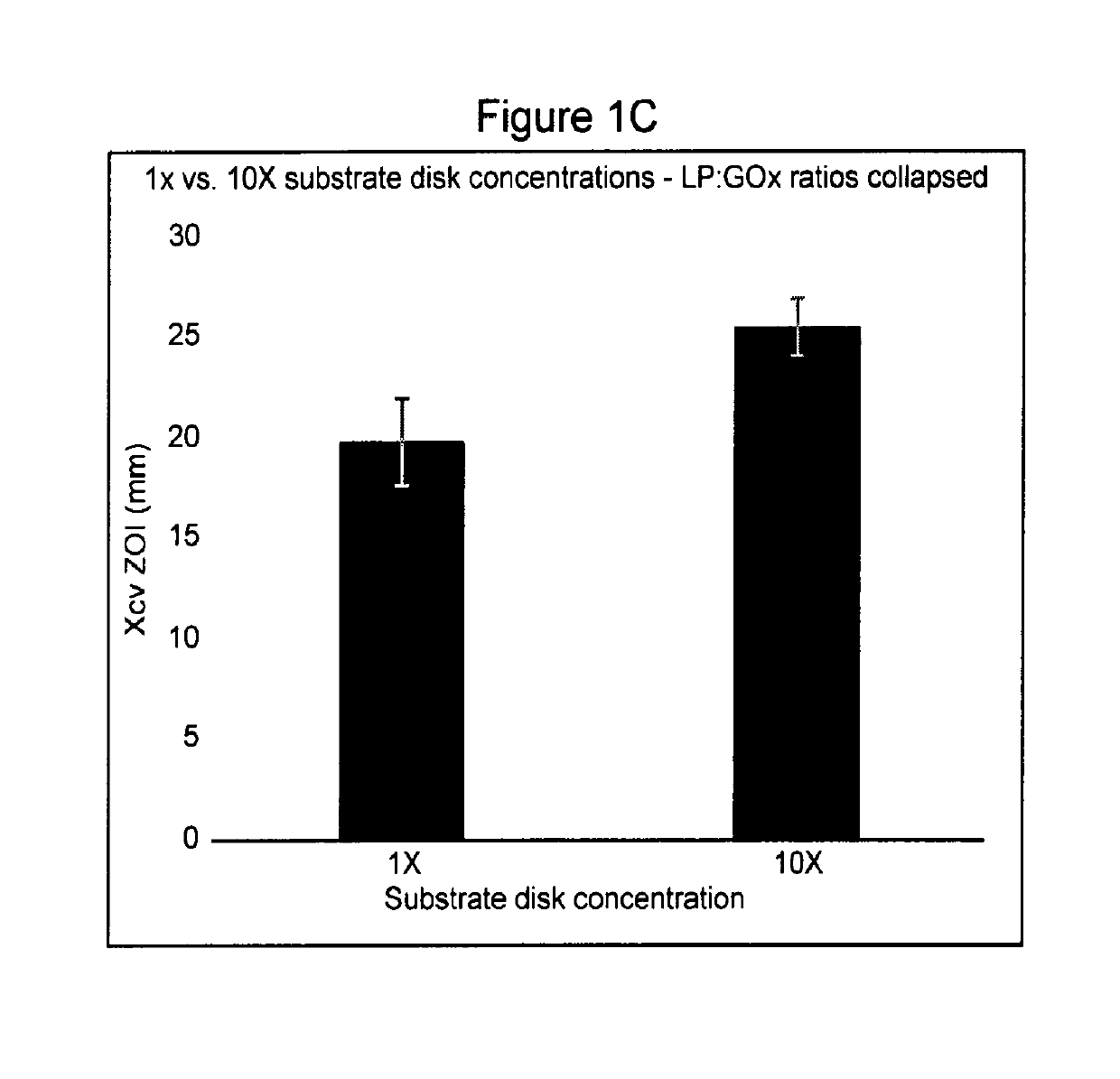Magnetically immobilized biocidal enzymes and biocidal chemicals
a biocidal enzyme and biocidal technology, applied in the field of magnetically immobilized biocidal enzymes and biocidal chemicals, can solve the problems of reducing the yield, quality and safety of agricultural and animal products worldwide, affecting human health and food security, and causing hundreds of billions of dollars in lost production, so as to reduce human infections, reduce microbial contamination or infection, and reduce resistan
- Summary
- Abstract
- Description
- Claims
- Application Information
AI Technical Summary
Benefits of technology
Problems solved by technology
Method used
Image
Examples
example 1
idal Optimization of Dry Enzyme and Substrate Disks
[0122]Materials and Methods
[0123]Five different lactoperoxidase (LP) to glucose oxidase (GOx) molar ratios were analyzed in dry enzyme disks to determine the optimal enzyme ratio for maximizing bactericidal activity. Two different concentrations of substrates in the dry substrate disks were also analyzed. These analyses were performed in-vitro on the bacterium Xanthomonas campestris pv. vitians isolate ‘09131A’ which was originally collected in New York State and isolated and identified by Christine Smart, Professor of Plant Pathology at Cornell University. (http: / / blogs.cornell.edu / smartlab / .)
[0124]A second analysis was done to determine the optimal enzyme concentration to inhibit fungal growth. Four concentrations of enzymes were analyzed in dry enzyme disks to determine the optimal enzyme concentration to maximize fungicidal activity. All analyses were performed in-vitro on plant-pathogenic microorganism cultures obtained from co...
example 2
etween Chemical Fungicides and Immobilized LP:GOx
[0139]Materials and Methods
[0140]The effect of combining commercial chemical fungicide with immobilized enzymes on microbial growth was analyzed in-vitro on two species of oomycete plant pathogens belonging to the genus Pythium. One isolate each of Pythium ultimum (isolate ‘Geneva 16’) and Pythium aphanidermatum (isolate ‘Pa58’) were both collected in New York State and isolated and identified by Professor Eric Nelson (Cornell University Section of Plant Pathology and Plant-Microbe Biology, Cornell University, Ithaca, N.Y.). https: / / pppmb.cals.cornell.edu / people / eric-nelson. Isolates were stored on corn meal agar (CMA).
[0141]A suspension of lactoperoxidase (LP) and glucose oxidase (GOx) was prepared in a 1:1 M ratio at a concentration of 1.613 μM and pH 7.4. Enzymes were immobilized by combining the 1.613 μM enzyme suspension with a 1.277 mg / ml nanoparticle (NP) suspension (pH 3) in a 1:1 volume ratio. Immobilized enzymes were then co...
example 3
etween Antibiotics and Immobilized LP:GOx
[0158]Materials and Methods
[0159]Antibiotic suspensions (ampicillin) were diluted to four concentrations so that the final amounts applied to sterile filter paper disks were 0.1 μg, 1 μg, 10 μg and 100 μg. The minimum inhibitory concentration (MIC) of ampicillin for Xanthomonas campestris was estimated to be between 10 μg and 50 μg. The MIC is defined as the lowest concentration of antibiotic that completely inhibits growth of the bacteria being evaluated and the minimum bactericidal concentration (MBC) is defined as the lowest concentration of antibiotic at which bacteria are killed. This was not determined for Xanthomonas campestris because resistant colonies persisted at the highest antibiotic concentration. Dry enzyme disks were made according to the formula in Table 3 with the exception of the enzyme concentration which is 238 nM. 10× dry substrate disks were made according to the formula in Table 2. The following treatments were analyze...
PUM
| Property | Measurement | Unit |
|---|---|---|
| size | aaaaa | aaaaa |
| particle size distribution | aaaaa | aaaaa |
| size | aaaaa | aaaaa |
Abstract
Description
Claims
Application Information
 Login to View More
Login to View More - R&D
- Intellectual Property
- Life Sciences
- Materials
- Tech Scout
- Unparalleled Data Quality
- Higher Quality Content
- 60% Fewer Hallucinations
Browse by: Latest US Patents, China's latest patents, Technical Efficacy Thesaurus, Application Domain, Technology Topic, Popular Technical Reports.
© 2025 PatSnap. All rights reserved.Legal|Privacy policy|Modern Slavery Act Transparency Statement|Sitemap|About US| Contact US: help@patsnap.com



